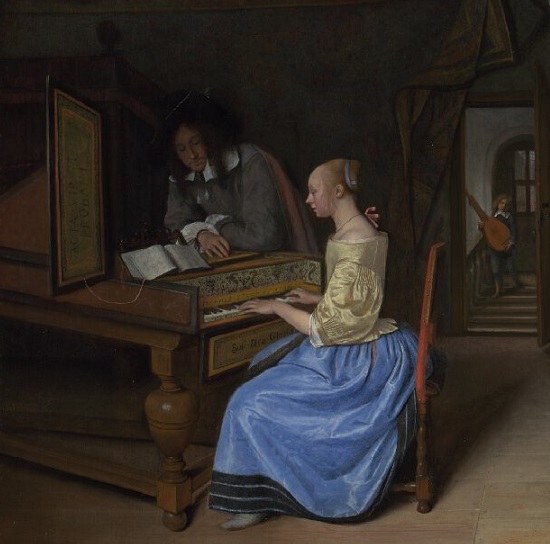User Group Leader: Sabrina Meloni
https://www.mauritshuis.nl/en/
Venue: National Gallery, London
Jan Steen (ca. 1626-1679) is one of the best-known artists of the Dutch Golden Age. His paintings are characterized by their attention to the humor and humanity of daily life. One key feature of his oeuvre remains elusive: its chronology. Steen was prolific, he worked in different cities, and his painting style and techniques varied. This has made dating his paintings complex and problematic. Only 10% of Steen’s surviving works were dated by the artist himself. The Mauritshuis has 15 paintings by Jan Steen in its collection (7 on panel and 8 on canvas), of which two are dated. In-depth technical and art historical research into Jan Steen’s oeuvre has been a focus at the Mauritshuis since 2012, as part of the Partners in Science project with Shell. Throughout the process of examining, treating and researching Steen’s paintings, conservators, curators and scientists have tried to unravel their chronology. This revealed the need for a broader study of his materials and techniques. Jan Steen worked in different areas of the Netherlands (Haarlem, The Hague, Delft, Leiden/ Warmond), each with a distinct artistic community. Our hypothesis is that he influenced, and was influenced by the artists around him and that he may have adapted his materials and techniques to local artistic traditions. We aim to gain more insight into the materials, painting techniques and chronology of paintings by Steen and his contemporaries using a combination of technical examination (stereo microscopy, IRR, X-radiography), scientific analysis (cross-section analysis, HH-XRF, MA-XRF, SEM-EDX), and art historical research.
At present we have analyzed 31 paintings by Steen, of which 11 paintings are dated. Within this group, all of the artistic centres Steen lived in are represented, some better than others. In addition to the 15 Mauritshuis paintings, access was granted by the Rijksmuseum Amsterdam, Museum Boijmans van Beuningen Rotterdam, Cultural Heritage Agency of the Netherlands, as well as the Royal Collections Trust to their paintings by Jan Steen for technical examinations. This included analysing existing samples, taking new samples, examination with infrared and XRF scanning and spot analysis. In collaboration with our Shell partners, we designed a database for the statistical analysis of Steen’s ground layers. Detailed data of the composition of the ground layers are placed in this database and analysed. By doing this we hope to see relationships between dated and undated paintings and to be able to link certain grounds to artistic centres Steen worked in.
Questions addressed by Access:
The National Gallery in London houses 11 paintings by Jan Steen. Of particular interest for our project are Young Woman playing Harpsichord to a Young Man (NG856), which is dated in 1659, and Peasants merry-making outside an Inn (NG2557) from his first artistic period, 1645-50. Steen’s earliest period (when he lived in Leiden) is presently only represented by one painting. Access to the technical documentation and existing cross-sections of the Steen paintings from the National Gallery was requested to broaden our insights into the painting technique of Jan Steen. Of particular interest were the ground layers used by Steen and his use of ultramarine, smalt, green earth and black pigments.
The objective of our visit to the National Gallery was to share the results of our analysis of Steen’s paintings in the Mauritshuis with the NG researchers and obtain data from the National Gallery’s paintings by Steen, to augment our knowledge of Steen’s painting technique in general and to add to our database for more specific analysis. The main objective of the Steen-project is to establish a better chronology of Steen’s work by combining art historical research with the results of scientific examinations. Our aim is to answer questions such as: How did Steen’s materials and techniques change over the course of his career? Which aspects of his painting technique were typical of the cities in which he worked? The answers to these questions might have art historical implications and help to place undated works in his oeuvre.
The ARCHLAB visit made it possible to enrich our research with valuable information on the ground layers and pigment use of Jan Steen. Elemental analysis of the ground layers of two of his paintings (NG856 and NG2560) was done together with Marika Spring and this data will be added to our database. Questions regarding a specific silicate-rich green pigment found in a few of Steen’s paintings were addressed. Data obtained from this pigment was compared to other Dutch 17th century paintings in which this pigment was found. Further analysis of Steen’s use of ultramarine was also discussed. The possibilities to analyse the quality of ultramarine based on the accessory minerals associated with it were discussed and preliminary results of this analysis were shared. We also discussed and compared our statistical database with the ground layer database that has been developed at the National Gallery for the IPERION grounds project by Marika Spring, Cristina Giancristofaro and Joe Padfield. All in all the visit provided great opportunities to share our knowledge and have fruitful discussions about our research.

